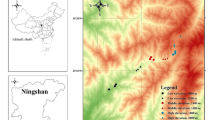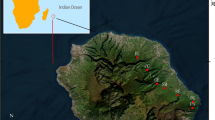Abstract
The Delhi Sands Flower-loving Fly (Rhaphiomidas terminatus abdominalis Cazier), the only Dipteran listed as endangered in the United States, is a large, nectar-feeding pollinator fly, found only in remnants of a sand dune ecosystem in southern California. A five-year observational study was conducted in a 3.7 ha preserve. Legal and biological constraints limit accuracy of population data because marking individuals was not possible. The population on the preserve appeared to be stable over the period of observation. Little variation in number of flies observed from year to year was found. Spatial distribution of fly observations differed for each fly generation, but reasons for this are not clear. Distribution of male and female flies differed from each other most of the time. Understanding aspects of the fly's ecology and behavior and the ecosystem dynamics is necessary to effectively plan for conservation and recovery of the species. Preserves must provide all of the elements needed for continued survival of the species through maintenance of its dynamic habitat.
Similar content being viewed by others
References
Canfield R.H. 1941. Application of the line intercept method in sampling range vegetation. J. Forestry 39: 288–394.
Cazier M.A. 1941. A generic review of the Family Apioceratidae with a revision of the North American species (Diptera-Brachycera). Am. Midl. Nat. 2: 589–631.
Cazier M.A. 1985. A revision of the North American flies belonging to the genus Rhaphiomidas (Diptera: Apioceridae). Bull. Am. Mus. Nat. Hist. 182: 181–263.
Cole F.R. 1969. The Flies of Western North America. Univ. of Calif. Press, Berkeley and Los Angeles.
Kingsley K.J. 1996. Behavior of the Delhi Sands Flower-loving Fly (Diptera: Mydidae), a Little-Known Endangered Species. Ann. Entomol. Soc. Am. 89: 883–891.
Peterson B.V. 1981. Apioceridae. In: McAlpine J.F., Peterson B.V., Shewell G.E., Teskey H.J., Vockeroth J.R. and Wood D.M. (eds), Manual of the Nearctic Diptera. Vol. 1. Research Branch, Agriculture Canada, Ottawa, Ontario, Canada, pp. 541–544.
Rogers R. and Mattoni R. 1993. Observations on the natural history and conservation biology of the giant flower loving flies, Rhaphiomidas (Diptera: Apioceridae). Dipter. Res. 4: 21–34.
Shafer C.L. 1990. Nature Reserves: Island Theory and Conservation Practice. Smithsonian Institution Press, Washington, DC.
US Fish and Wildlife Service 1997. Delhi Sands Flower-loving Fly (Rhaphiomidas terminatus abdominalis) Recovery Plan. US Fish and Wildlife Service, Portland, OR, USA.
Author information
Authors and Affiliations
Rights and permissions
About this article
Cite this article
Kingsley, K.J. Population Dynamics, Resource Use, and Conservation Needs of the Delhi Sands Flower-loving Fly (Rhaphiomidas Terminatus Abdominalis Cazier) (Diptera: Mydidae), an Endangered Species. Journal of Insect Conservation 6, 93–101 (2002). https://doi.org/10.1023/A:1020995200244
Issue Date:
DOI: https://doi.org/10.1023/A:1020995200244




